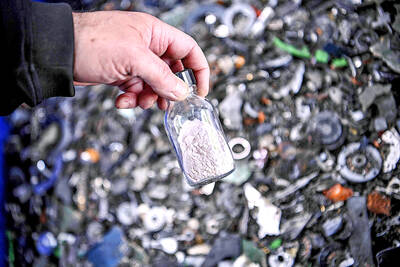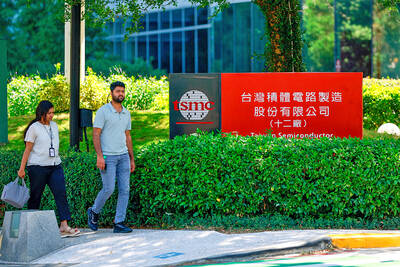Expected sales of the Airbus SAS A330 series aircraft may last beyond 2020, as the company aims to secure more orders from both regular and budget airlines, a company official said on Friday.
The France-based aircraft manufacturer’s statement comes as the company is to deliver a mid-range wide-body A330-300 plane to TransAsia Airways Corp (TNA, 復興航空) — one of the three listed airlines in Taiwan — in Toulouse, France, today.
“A330 is the most economical and advanced wide-body aircraft in service today,” Marino Modena, a product marketing manager for the Airbus 330 and 340 aircraft series, told a media briefing.
Modena said the company had evaluated in an internal meeting that sales momentum for the A330 family could continue for at least 10 years, attributing the optimistic forecast to the company’s continuous efforts to improve the A330 series.
Airbus has spent US$200 million per year in raising A330 series’ competitiveness by innovating and transferring its technology and systems, the company said in a report.
Other than service upgrades, these innovations successfully boosted the plane’s cost efficiency by lowering its cash operating cost by 10 percent compared with its peers, the report said.
In addition, A330 series aircraft are charactarized by their high flexibility as they can be used to operate routes between 30 minutes and 14 hours, Modena said.
That has driven up demand from regular airlines needing to replace their fleet, as well as from budget carriers focusing on regional routes, he added.
Airbus has received 2,160 orders for A330 series aircraft since it began service in 1993, with 1,283 planes already delivered to clients, the report’s data showed.
Orders for the A330-300 aircraft, which has 300 seats, reached 598 as of the end of September, accounting for more than a fourth of total orders of A330 aircrafts, data showed.
Fifty percent of A330-300 aircraft orders have been placed by carriers in the Asia-Pacific region, while European and North American carriers account for 24 percent and 18 percent respectively.
TransAsia Airlines ordered two A330-300 planes in November 2010, with one scheduled to be delivered today. The second is expected to be delivered in January. Both aircraft are set to operate on routes to Singapore and Osaka, Japan, TransAsia Airlines said in an earlier statement.
Neither Airbus nor TransAsia specified the price paid the two A330-300 planes. Sources from the companies said the listed price for an A330 is between US$150 million and US$200 million. However, airlines usually receive discounts from aircraft makers and the final price is rarely disclosed.
TransAsia is to become the third carrier in Taiwan that has added A330-300 aircraft to its fleet, after China Airlines Ltd (CAL, 中華航空) and EVA Airways Corp (EVA, 長榮航空).
Airbus remained upbeat about next year’s prospects for the aerospace industry, expecting passenger traffic to grow at a steady pace with an average annual rate of 4.7 percent between this year and 2031.
Overall, Airbus forecast a total of about 28,200 new passenger jets and freighters worth nearly US$4 trillion by all manufacturers over the next 20 years, a 1.3 percent increase from a 27,850 estimate for jet deliveries given by Airbus last year, when the aircraft maker raised its 20-year forecast by 7.7 percent.
Emerging economic regions are estimated to represent more than half of all traffic growth in the next 20 years, with new aircraft deliveries in the Asia-Pacific region set to account for 35 percent of all deliveries, the statement said.
Airbus posted consolidated revenues of 25.62 billion euros (US$33.23 billion) in the first nine months of the year, up 14 percent from a year earlier, with consolidated earnings before interest and tax rising by 184 percent from a year ago to 837 million euros, according to company data.

RECYCLE: Taiwan would aid manufacturers in refining rare earths from discarded appliances, which would fit the nation’s circular economy goals, minister Kung said Taiwan would work with the US and Japan on a proposed cooperation initiative in response to Beijing’s newly announced rare earth export curbs, Minister of Economic Affairs Kung Ming-hsin (龔明鑫) said yesterday. China last week announced new restrictions requiring companies to obtain export licenses if their products contain more than 0.1 percent of Chinese-origin rare earths by value. US Secretary of the Treasury Scott Bessent on Wednesday responded by saying that Beijing was “unreliable” in its rare earths exports, adding that the US would “neither be commanded, nor controlled” by China, several media outlets reported. Japanese Minister of Finance Katsunobu Kato yesterday also

Jensen Huang (黃仁勳), founder and CEO of US-based artificial intelligence chip designer Nvidia Corp and Taiwan Semiconductor Manufacturing Co (TSMC, 台積電) on Friday celebrated the first Nvidia Blackwell wafer produced on US soil. Huang visited TSMC’s advanced wafer fab in the US state of Arizona and joined the Taiwanese chipmaker’s executives to witness the efforts to “build the infrastructure that powers the world’s AI factories, right here in America,” Nvidia said in a statement. At the event, Huang joined Y.L. Wang (王英郎), vice president of operations at TSMC, in signing their names on the Blackwell wafer to

‘DRAMATIC AND POSITIVE’: AI growth would be better than it previously forecast and would stay robust even if the Chinese market became inaccessible for customers, it said Taiwan Semiconductor Manufacturing Co (TSMC, 台積電) yesterday raised its full-year revenue growth outlook after posting record profit for last quarter, despite growing market concern about an artificial intelligence (AI) bubble. The company said it expects revenue to expand about 35 percent year-on-year, driven mainly by faster-than-expected demand for leading-edge chips for AI applications. The world’s biggest contract chipmaker in July projected that revenue this year would expand about 30 percent in US dollar terms. The company also slightly hiked its capital expenditure for this year to US$40 billion to US$42 billion, compared with US$38 billion to US$42 billion it set previously. “AI demand actually

RARE EARTHS: The call between the US Treasury Secretary and his Chinese counterpart came as Washington sought to rally G7 partners in response to China’s export controls China and the US on Saturday agreed to conduct another round of trade negotiations in the coming week, as the world’s two biggest economies seek to avoid another damaging tit-for-tat tariff battle. Beijing last week announced sweeping controls on the critical rare earths industry, prompting US President Donald Trump to threaten 100 percent tariffs on imports from China in retaliation. Trump had also threatened to cancel his expected meeting with Chinese President Xi Jinping (習近平) in South Korea later this month on the sidelines of the APEC summit. In the latest indication of efforts to resolve their dispute, Chinese state media reported that